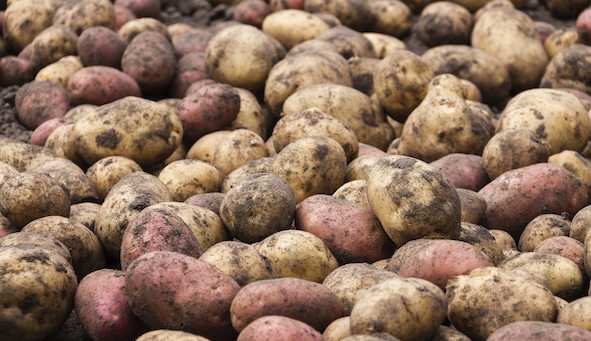It’s time to start seriously thinking about your storage program. No, considering storage before harvest isn’t putting the cart before the horse. As farmers, processors and the overall industry is slowly shifting to understand, getting the best quality and most salable volume from stored potatoes requires a multi-phase, well-considered storage management program, not a one-off sprout control application.
Harvesting potatoes is long, hard, intense work. When potatoes need to come out of the ground, it can be difficult to spend even a moment thinking about any other farm task. That’s why most farmers harvest through September and October but wait until potatoes finish suberizing in November or December before they shift their attention to storage management. For farmers willing to rely exclusively on CIPC, delaying thought about storage doesn’t matter so much, since CIPC stresses tubers when applied too early. However, proactive farmers are increasingly realizing that dormancy enhancement applied much earlier can offer real return on investment, especially in stressed piles.
1,4DMN (1,4-Dimethylnaphthalen), formulated as 1,4Sight™ for table stock and processing potatoes and 1,4Seed™ for seed stock, is the only true dormancy enhancer available on the North American market today. Applied right at or soon after bin close-up, 1,4-DMNhelps settle a pile. In addition to inhibiting sprouting, 1,4DMN triggers health maintaining and water loss limiting genes that retain tuber quality and minimize both shrinkage and fungal spread. On short-dormancy varieties, 1,4DMN can be used as a stand-alone to maintain dormancy and quality and keep moisture-loss in check immediately post-harvest. On longer-dormancy varieties, 1,4DMN can be applied at close-up and then followed with later applications of either CIPC or 1,4DMN after suberization.
But wait, you’re not done once your post-suberization treatment goes on. Far too many farmers accept some level of sprouting in their stored crop. That’s partially because processors typically accept up to an inch and a half of sprouting, and partially because farmers may not fully recognize the cost of even tiny sprouts. I’ve seen piles – even with just small sprouts – drop up to three feet through a storage season as those sprouts act as little chimneys, wasting valuable moisture volume. 1,4Zap™ offers in the range of 95 per cent burn-back with limited scent issues and post-application worker safety issues.
Treating your potatoes with a comprehensive storage management program from harvest through shipping can pay big dividends. Though storage season may still feel a ways off, it’s never to early to get prepared.








